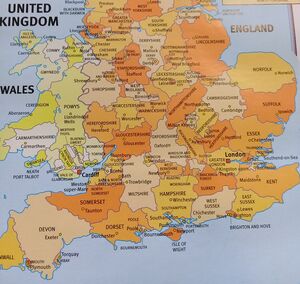Norfolk
| Author:Laxman Burdak, IFS (R) |

Norfolk (नारफोक) is a county in East Anglia, geographical area comprises the counties of Norfolk, Suffolk and Cambridgeshire in England.
Location
It borders Lincolnshire to the northwest, Cambridgeshire to the west and southwest, and Suffolk to the south. Its northern and eastern boundaries are the North Sea and, to the north-west, The Wash. The county town is Norwich. Norfolk is a largely rural county with a population density of 401 per square mile.
History
Norfolk was settled in pre-Roman times, with camps along the higher land in the west, where flints could be quarried. A Brythonic tribe, the Iceni, inhabited the county from the 1st century BC to the end of the 1st century AD. The Iceni revolted against the Roman invasion in AD 47, and again in 60 led by Boudica. The crushing of the second rebellion opened the county to the Romans. During the Roman era roads and ports were constructed throughout the county and farming was widespread.
Situated on the east coast, Norfolk was vulnerable to invasions from Scandinavia and Northern Europe, and forts were built to defend against the Angles and Saxons. By the 5th century the Angles, after whom East Anglia and England itself are named, had established control of the region and later became the "north folk" and the "south folk", hence, "Norfolk" and "Suffolk". Norfolk, Suffolk and several adjacent areas became the kingdom of East Anglia (one of the heptarchy), which later merged with Mercia and then with Wessex.
The influence of the Early English settlers can be seen in the many place names ending in "-ton" and "-ham". Endings such as "-by" and "-thorpe" are also common, indicating Danish place names: in the 9th century the region again came under attack, this time from Danes who killed the king, Edmund the Martyr. In the centuries before the Norman Conquest the wetlands of the east of the county began to be converted to farmland, and settlements grew in these areas. Migration into East Anglia must have been high: by the time of the Domesday Book survey it was one of the most densely populated parts of the British Isles. During the high and late Middle Ages the county developed arable agriculture and woollen industries. Norfolk's prosperity at that time is evident from the county's large number of medieval churches: out of an original total of over one thousand, 659 have survived, more than in the whole of the rest of Great Britain.[1] The economy was in decline by the time of the Black Death, which dramatically reduced the population in 1349. By the 16th century Norwich had grown to become the second largest city in England; but over one-third of its population died in the plague epidemic of 1579,[2] and in 1665 the Great Plague again killed around one-third of the population.[3] During the English Civil War Norfolk was largely Parliamentarian. The economy and agriculture of the region declined somewhat. During the Industrial Revolution Norfolk developed little industry except in Norwich which was a late addition to the railway network.
In the 20th century the county developed a role in aviation. The first development in airfields came with the First World War; there was then a massive expansion during the Second World War with the growth of the Royal Air Force and the influx of the American USAAF 8th Air Force which operated from many Norfolk airfields.
For the local army regiments the Royal Norfolk Regiment and the Norfolk Yeomanry please click on the links.
During the Second World War agriculture rapidly intensified, and it has remained very intensive since, with the establishment of large fields for growing cereals and oilseed rape.
Rural life

External links
References
- ↑ "Medieval Churches in Norfolk :: Geograph Britain and Ireland". Geograph.org.uk. 24 September 2010.
- ↑ "Voices of the Powerless: Boils and Buboes". BBC Radio 4. 29 August 2002
- ↑ 4Seen web construction, Judi Ingram. "About the History of Norfolk". Archived from the original on 2003-01-01.
- ↑ Rural Britain Then and Now : A Celebration of the British Countryside Featuring Photographs from the Francis Frith Collection by Roger Hunt, Forward by Sir Simon Jenkins, 2009, by Bounty Books, isbn:978-0-753719-53-4, p.103

